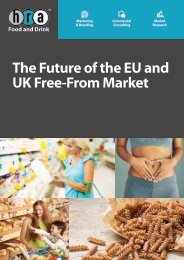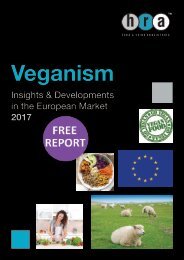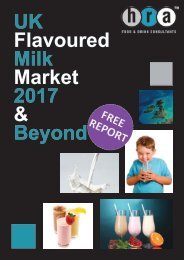FREE-UK-Flavoured-Milk-Report-2016-2017
The backdrop to the UK flavoured milk market is one of relentless change. The removal of the EU milk quotas, the transition to a Western-type diet by emerging economies, the UK sugar debate and the booming sports nutrition industry are all aspects of change that create both challenges and opportunities for the UK flavoured milk market. HRA Food and Drink Marketing has developed this report as a map to guide industry stakeholders. Although volume growth in 2014 was slightly lower than in previous years, the flavoured milk market still has plenty of room for product innovation and development. Overall, we expect the UK flavoured milk market to continue to grow over the medium term, but not without improving its nutritional profile. The sugar debate reached new heights when, in October 2015, Public Health England released a document suggesting Government intervention in the form of a sugar tax (levy). As a consequence, product reformulation has become a priority for all serious players in the market.
The backdrop to the UK flavoured milk market is one of relentless change. The removal of the EU milk quotas, the transition to a Western-type diet by emerging economies, the UK sugar debate and the booming sports nutrition industry are all aspects of change that create both challenges and
opportunities for the UK flavoured milk market.
HRA Food and Drink Marketing has developed this report as a map to guide industry stakeholders. Although volume growth in 2014 was slightly lower than in previous years, the flavoured milk market still has plenty of room for product innovation and development.
Overall, we expect the UK flavoured milk market to continue to grow over the medium term, but not without improving its nutritional profile. The sugar debate reached new heights when, in October 2015, Public Health England released a document suggesting Government intervention in the form of a sugar tax (levy). As a consequence, product reformulation has become a priority for all serious players in the market.
You also want an ePaper? Increase the reach of your titles
YUMPU automatically turns print PDFs into web optimized ePapers that Google loves.
<strong>UK</strong>#FLAVOURED#MILK#<strong>2016</strong>217#<br />
#<br />
1.5 Growth and Development<br />
•#<br />
•#<br />
•#<br />
•#<br />
Nutrition in the first years of life are fundamental to a young person’s life,<br />
with stunting linked to reduced child morbidity and impaired cognitive<br />
development (9).<br />
Stunting and low birth weight increases the risk of chronic disease in<br />
adults (11). <strong>Milk</strong> has been found to affect and improve the growth of<br />
undernourished children (10).<br />
In developed countries, milk is used in a great deal of programs intended<br />
to address malnutrition and underfed patients (16).<br />
Evidence suggests that a diet containing at least one glass of milk (250ml)<br />
can provide 25-33% of protein requirements in children from 1 to 5 years<br />
of age and have a positive impact on their weight gain and linear growth<br />
(15).<br />
Bone Health<br />
IGF-1 is a protein in milk that plays an important role in the body, one of<br />
which is the assimilation of amino acids. Amino acids contribute to the<br />
formation of protein and bone length (20).<br />
In addition, research suggests diets with low levels of dairy are linked to a<br />
higher risk of osteoporosis (14). Similarly, children with diets lacking in dairy<br />
products have been found to suffer from an increased risk of fracture (12).<br />
Oral Health<br />
Evidence suggests that the regular consumption of milk may prevent cavities<br />
and contribute to good oral health (7). Specifically, children and adults with<br />
high levels of calcium and phosphate covering their teeth enamel had lower<br />
rates of dental cavities (18).<br />
Weight Control and Obesity<br />
There is evidence suggesting that increasing protein intake with constant<br />
overall energy consumption could contribute towards weight control and<br />
body composition. This is thought to be derived from possible increased<br />
thermogenesis and satiety (6).<br />
Metabolic Syndrome and Type 2 Diabetes<br />
Metabolic Syndrome refers to a set of irregularities in the metabolism that<br />
include: obesity, hypertension, high glucose, and high triglycerides (HDL)<br />
(17). Diets with high dairy content have been associated with lower levels of<br />
some elements of Metabolic Syndrome (19).<br />
Cardiovascular Disease<br />
Although there is no clear single publication establishing the relationship<br />
between dairy intake and cardiovascular disease, current knowledge<br />
# 18#<br />
All rights reserved, ©Teepee#Ltd,#t/a#HRA#Food#&#Drink:#<strong>2016</strong>#<br />
to#<strong>2017</strong>#







